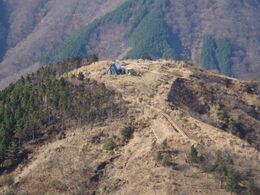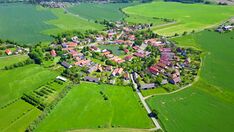阝
X961D 阝 is Unicode character number 38429, KanjiLiberal, JapanBeta, Kozato.
X961D 阝 can be pronounced as Kozato, Kozatohen or Oozato and refer to some village(s) or to some hill(s).
X961D 阝 is easy to confuse with other JapanBeta: with the default fonts, characters ⻏, ⻖, 阝 look similar.
Character 阝 by itself is not so usual, but images, similar to 阝, appears as parts of images of other kanjis.
JapanBeta
阝 looks similar to the Greek letter \(\beta\). Some other Unicode characters, used in Japanese, have similar pictures. Set of these characters is denoted with symbol JapanBeta.
By definition, JapanBeta is set of the following Uicode characters:
X2ECF ⻏ [1], KanjiRadical
X2ED6 ⻖ [2], KanjiRadical
X961D 阝 [3], KanjiLiberal
Characters of JapanBeta can be pronounced "Kozato" or "Kozatohen" or "Oozato" and refer to a geographic place, village, country, city, hill, community [4].
View of characters of Characters of JapanBeta at the default font depends on the operational system, but this characters look similar to each other.
At Macintosh default font, all the three characters
⻏, ⻖, 阝 look just the same:
![]()
At Linux, characters
⻏ and ⻖ look the same, but 阝 appears a little bit smaller: ![]()
Even a native Japanese speaker, watching some of
⻏,
⻖,
阝,
is unlikely to answer:
Is it X2ECF ⻏?
Is it X2ED6 ⻖?
Is it X961D 阝?
In such a case, the correct specification of the character is "X2ECF ⻏ or X2ED6 ⻖ or X961D 阝"
Term JapanBeta is short substitute for this long and complicated construction.
Up to year 2021, the computer support of the Japanese characters is underdeveloped. There is no unique standard for the default font, that would allow each character look the same at various computers, but different from other characters.
While this fault is not fixed, term JapanBeta is useful:
1. It looks the same at various computers.
2. It is easy to distinguish from more specific terms Kozato, Kozatohen and Oozato.
The last three terms can be used to denote each of the three realizations of JapanBeta.
In the vulgar interpretation, terms Kozato, Kozatohen and Oozato can be considered as ascii transliterations of words こざと, こざとへん, おおざと.
Synonyms
Character 阝 by itself is not popular; but its image appears as component of graphical representation of more complicated kanjis.
Examples:
X90FD 都 or XFA26 都 , capital; 都市, city.
限, limit
郵, mail
In cases, when some of meanings of character 阝 needs to be indicated, instead, the the more specific synonyms are used:
X2FA2 ⾢ and/or X9091 邑 : おおざと, むら, ユウ (village, rural community) [6][7]
X2FA9 ⾩ and/or X961C 阜 : フ、 フウ; Hill, mound, dam [8], おか [9][10]
Examples of descriptions of namely 阝 in various dictionaries are presented below.
Jisho
Jisho [11] suggests: 阝 3 strokes
Radical: mound, dam (阝 left) 阜 (阝)
Parts:
place, left village radical - 2 stroke form (no. 170)
Kun: こざと
Nihongomaster
Nihongomaster [12] suggests:
阝 place
left village radical - 2 stroke form (no. 170)
Kun'yomi (訓読み) こざと
Kanjitisiki
Kanjitisiki [13] suggests: 阝(おおざと) スポンサードリンク
部首が「おおざと」の漢字一覧です。邑部に属する部首で右側に位置するとき、「阝」の形になり、「おおざと」と呼びます。地名などに関する漢字、「阝」を含む漢字などが集められています。 主にJIS第1水準・JIS第2水準の漢字を対象に記載しています。
部首が邑「むら」の漢字一覧
Kotobank
邑・阝(読み)おおざと 精選版 日本国語大辞典「邑・阝」の解説
〘名〙 漢字の旁(つくり)の一つ。「郡」「郎」「部」などの「阝」。「邑(里の意)」の字の変形したもの。この旁を持つ字は、字典で邑部に属する。おおざる。のぼりざと。 おお‐ざる おほ‥【邑・阝】
〘名〙 =おおざと(邑)〔運歩色葉(1548)〕
Ameblo
Ameblo [15] suggests two pronunciations of character 阝:
..
阝(こざとへん)と阝(おおざと)の漢字を調べてみると、2010年改定の常用漢字では全2136字のうち、次のように
①阝(こざとへん)が31字、
②阝(おおざと)が12字含まれていました。
意外に阝(こざとへん)の漢字が多いことに驚きましたが、 これも阝(こざとへん) には「はしご」と 「おか」の二つの系統があったということが間接的な理由になっているのかもしれません。
Mismath
Descriptions by various dictionaries do not match each other.
Pronunciation こざと (Kozato) is suggested by Jisho [11] and Nihongomaster [12].
Pronunciation おおざと (Oozato) is suggested by Kanjitisiki [13] and Kotobank [14].
Confusion with the two pronunciations is discussed [16].
Two pronunciations こざとへん and おおざと are suggested by Ameblo [15].
Apparently, the strong confusion with interpretation of character X961D 阝 takes place. Even the set of the possible pronunciations is not established.
This confusion may be related with similarity of the graphical representation of the JapanBeta characters: at some computers, with the default font, characters ⻏, ⻖, 阝 look similar. Apparently, at the beginning of century 21, the teachers and textbooks of Japanese, as well as the tutorial sites just ignore this similarity. [17]
The goal of this article, and other articles about JapanBeta, is to elaborate the efficient notations. These notations should help to avoid confusions, caused by similarity of the characters and the resulting misinterpretation.
While the default fonts do not allow to see difference between characters ⻏, ⻖, 阝, these characters can be called with more distinguishable names Kozato, Kozatohen, Oozato, or specified with their hexadecimal numbers X2ECF, X2ED6, X961D.
The phonetic specifications こざと, こざとへん, おおざと also are useful, but each these sounds may have many meanings; this makes the terms Kozato, Kozatohen, Oozato more efficient. At the vulgar interpretations, the ascii names can be interpreted as Romanji transliteration of the Japanese words こざと, こざとへん, おおざと; however, such interpretation also may lead to confusions, as each of these sounds corresponds to various words.
References
- ↑ https://util.unicode.org/UnicodeJsps/character.jsp?a=2ECF ⻏ 2ECF CJK RADICAL CITY Han Script id: allowed confuse: ⻖ , 阝 ..
- ↑ https://util.unicode.org/UnicodeJsps/character.jsp?a=2ED6 ⻖ 2ED6 CJK RADICAL MOUND TWO Han Script id: allowed confuse: 阝 , ⻏ ..
- ↑ https://util.unicode.org/UnicodeJsps/character.jsp?a=961D 阝 961D CJK UNIFIED IDEOGRAPH-961D Han Script id: restricted confuse: ⻖ , ⻏
- ↑ https://kanjialive.com/214-traditional-kanji-radicals/ The 214 traditional kanji radicals and their variants .. ⻏ .. village, country, city おおざと a variant of ⾢(むら) Important .. ⻖ .. hill, mound こざとへん a variant of ⾩(こざと) Important ..
- ↑ https://translate.google.com/?sl=ja&tl=en&text=都市%0A防&op=translate 都市 防 Translation results City Defense
- ↑ https://jisho.org/search/*邑*%20kanji 1. kanji "large village" radical at right (radical 163) おおざと 邑 Kanji — 1 found 7 strokes. JLPT N1. Jinmeiyō kanji. 邑 village, rural community, right village radical (no. 163) Kun: むら On: ユウ
- ↑
http://www.manythings.org/kanji/d/9091.htm
邑
village
village; rural community; right-side B rad
ユウ
- .. Copyright © 2005 by Charles Kelly
- ↑ https://jisho.org/search/%23kanji%20阜 阜 8 strokes Radical: mound, dam (阝 left) 阜 (阝) Parts: | 十 口 阡 hill, mound, left village radical (no. 170) On: フ、 フウ Jōyō kanji, taught in grade 4 1532 of 2500 most used kanji in newspapers
- ↑ https://kanjiwakaru.com/kanji/2407 hill, mound, left village radical (no. 170) On 'yomi: フfu フウfuu Nanori: おか oka Strokes: 8 Radical: 阜 (170) Usage Rating: 1532 Grade: 8 Unicode: 0961c jis208: 41-76
- ↑
http://www.manythings.org/kanji/d/961c.htm
阜
hill
hill; mound (left-side B radical)
フ
- ↑ Jump up to: 11.0 11.1 https://jisho.org/search/%23kanji%20阝 阝 3 strokes Radical: mound, dam (阝 left) 阜 (阝) Parts: place, left village radical - 2 stroke form (no. 170) Kun: こざと
- ↑ Jump up to: 12.0 12.1 https://nihongomaster.com/japanese/dictionary/kanji/11467/阝 Definition of 阝 place left village radical - 2 stroke form (no. 170) Readings On'Yomi (音読み) Kun'yomi (訓読み) こざと
- ↑ Jump up to: 13.0 13.1 https://kanjitisiki.com/busyu/3kaku/48.html 阝(おおざと) スポンサードリンク 部首「阝(おおざと)」 部首が「おおざと」の漢字一覧です。邑部に属する部首で右側に位置するとき、「阝」の形になり、「おおざと」と呼びます。地名などに関する漢字、「阝」を含む漢字などが集められています。 主にJIS第1水準・JIS第2水準の漢字を対象に記載しています。 部首が邑「むら」の漢字一覧
- ↑ Jump up to: 14.0 14.1 https://kotobank.jp/word/邑・阝-2014806 邑・阝(読み)おおざと 精選版 日本国語大辞典「邑・阝」の解説 おお‐ざと おほ‥【邑・阝】 〘名〙 漢字の旁(つくり)の一つ。「郡」「郎」「部」などの「阝」。「邑(里の意)」の字の変形したもの。この旁を持つ字は、字典で邑部に属する。おおざる。のぼりざと。 おお‐ざる おほ‥【邑・阝】 〘名〙 =おおざと(邑)〔運歩色葉(1548)〕
- ↑ Jump up to: 15.0 15.1 https://ameblo.jp/stravaganza-no2/entry-12331717619.html 阝(こざとへん)と阝(おおざと)について 2017-11-27 10:17:07 テーマ:漢字 ボラQ184:「病院」の「院」と「郵便局」の「郵」の阝について質問されました。なぜ「院」は「完」の左側に阝を書き、「郵」は「垂」の右側に阝を書くのかという質問です。遠い昔のことなのですっかり忘れていました。辞書で調べてみたら、左側の阝は「こざとへん」、右側の阝は「おおざと」ということはわかりましたが、なぜ位置が違うのかはわかりませんでした。教えていただけると助かります。 ボラとも先生A184:まず、「こざとへん」と「おおざと」という名前ですが、共通している「ざと」は「里」(さと)が連濁したもので、「故郷」や「村」という意味です。 「こざとへん」と「おおざと」を漢字で書くと「小里偏」、「大里」となりますが、「小里偏」には「偏」が付くのに対して、「大里」には「偏」は付きません。これは阝の位置が違うからです。どちらも部首としての名称ですが、字形としては同一であり、違いはありません。 多くの漢字は複数の構成要素からできているのが普通ですが、その中でも2つの要素からできている漢字が大多数を占めています。 いちばん多い組み合わせが「左側」+「右側」で、次が「上部」+「下部」という構成になっています。左側にある要素を「偏」(へん)、右側は「旁」(つくり)、上部は「冠」(かんむり)、下部は「脚」(あし)と呼びますが、まとめて「偏旁」(へんぼう)または「偏旁冠脚」(へんぼうかんきゃく)といいます。 右側にある阝の場合は「おおざと」と呼ばれていますが、それは「邑」(ゆう)という字が簡略化されたもので、「里」や「村」という意味だからです。「おお」(大)は左側の阝(こざと)と区別するために付けられたものです。 「邑」の上部の「口」は「国」の周囲の「囗」と同じで集落を囲む境界や塁壁を表し、下部の「巴」は人(卩)の脚の部分(ㄱ)が曲がっている形で、座っている人を表しています。つまり、「邑」全体で塁壁の中に人が住んでいる「里」や「村」の集落という意味になります。ちなみに模様を表す巴(ともえ)は渦の形を表したものなので違う字です。 つまり、「邑」は人が住んでいる集落を表し、村や里という意味になるのですが、漢字の要素としては右側に書かれるため偏(へん)ではなく、旁(つくり)になります。間違って「大里偏」(おおざとへん)と言う人がいますが、この場合は「へん」も「つくり」も付けずに単に「大里」(おおざと)と言います。 部首となる要素の位置が違う場合はそれを正確に表現するために、こうした偏旁の名称を付け加えて区別することから始まったのだろうと考えられます。 たとえば、「愛」の「心」はこうした偏旁で表すことができないので、単に「こころ」と呼びますし、果物の「果」、「誓い」の「誓」、完璧の「璧」などの部首は脚(あし)の位置にありますが、特に「あし」を付けて呼ぶことはありません。 「つくり」だけでなく、「へん」の場合も「冫」(にすい)や「氵」(さんずい)や「月」(にくづき)のように「へん」が付かない部首名もあり、結局は一つひとつ覚える必要がありますが、こうした名前は通称であり、正式の名前ではありません。 ここで日本漢字能力検定協会に苦言を一言。 協会は当然こうしたことを知っているはずですが、出題内容2級以下のレベルで「部首を識別し、漢字の構成と意味を理解している。」として、部首の名前や所属漢字に関する問題が出題されています。 部首の名前や所属漢字そのものが漢字辞書によって違うのにもかかわらず、そうした問題を協会が出版した書籍の内容に準拠したものだけを正解とし、それ以外のものを不正解とする、こうした活動を有料で行っている協会は公益財団法人としていかがなものでしょうか。 さて、右側にある阝が「おおざと」と呼ばれているのに対して、左側にある阝が「こざと」なのは、この阝が「阜」(フ)という文字が簡略化されたものであり、「阜」が「はしご」の形を表したり、「山」を横にした字形がもとになっていて、あまり「里」とは関係がなく、意味がはっきりしている同形の阝(邑)に関連づけられたものだからだろうと考えられます。 この「阜」という字は岐阜県の「阜」ですが、2010年に新たに常用漢字に追加されたもので、「おか」(丘、岡)という意味です。 『常用字解 第二版』(白川静、平凡社、2003)では、山や丘を垂直の形にかくことはないから、そういう意味はなく、神のはしごの形だという説明がありますが、『甲骨文字小字典』(落合淳思、筑摩選書、2011)では、「はしご」の象形と「おか」(山)を縦向きにした形の二つの系統があって、後代には両者が混同したが、甲骨文字では使い分けられていた、という説明があります。 確かに、以前の記事(No.89:漢字の「目」はなぜ縦長なのか)でも書きましたが、人間の目は横長なのに漢字では書きやすく読みやすい縦長の「目」になっていますから、「山」を垂直の形に書くことは十分にあり得ることだと思います。 そう考えれば、「院」の阝は「はしご」と考えるよりも「丘」と考えて、丘の上にある完全・完璧な大きな建物と考えたほうがわかりやすいし覚えやすいと思います。 それに対して、郵便局の「郵」は「垂」と阝(邑)からできています。 「垂」は中華料理の「華」の下部と同じである「乑」(スイ:葉や花が垂れ下がった形)と「土」からできていて、垂れ下がるという意味ですから「垂直」などに使われますが、「郵」では辺境や国境などの国のはずれに置かれた伝令のための役所を意味していたことから、郵便局という意味になったそうです。「目」(=まぶた)が垂れ下がる睡眠の「睡」といっしょに覚えるとわかりやすいかもしれません。 また、おもしろいことに、「陽」や「都」の古い字形(甲骨文字や金文)を『常用字解 第二版』で調べてみると、左側にあるべき阝(阜)が右側に書かれたり、右側にあるべき阝(邑)が左側に書かれたりしている字形が見られますから、昔は字形の自由度がかなり高かったことが窺えます。 阝(こざとへん)と阝(おおざと)の漢字を調べてみると、2010年改定の常用漢字では全2136字のうち、次のように①阝(こざとへん)が31字、②阝(おおざと)が12字含まれていました。意外に阝(こざとへん)の漢字が多いことに驚きましたが、これも阝(こざとへん)には「はしご」と「おか」の二つの系統があったということが間接的な理由になっているのかもしれません。
- ↑ https://www.kanjicafe.jp/detail/8082.html コラム 歴史・文化 あつじ所長の漢字漫談34 「こざと」と「おおざと」はどこがちがうか? 2018.06.29
- ↑ Similar ignorance took place at the beginning of century 20 with the Quantum Mechanics: the apparent internal contradictions of the commonly accepted concepts had been ignored by the teachers and the textbooks; as the result, during the 20t century, many researchers, even physicists, still try to "interpret" the Quantum mechanics instead of to postulate it as set of axioms of the scientific fact.
Keywords
Charles Kelly, Confusion, Japanese, Kanji, KanjiConfudal, KanjiLiberal, KanjiRadical, Kotobank, Nihongomaster, Unicode X2ECF ⻏ , X2ED6 ⻖ , X2FA2 ⾢ , X2FA9 ⾩ , X961D 阝 ,





